The Tibetan Amṛtasiddhi text, composed by Amoghavajra and attributed to Virūpa, may be the oldest known yoga text to describe a wide range of complex, non-seated postures (lus gnad). In my article titled “Yoga Posture and Forceful Yoga: Amoghavajra’s Tibetan Amṛtasiddhi Text”, published in the Journal of Yoga Studies, I examine a number of these postures, many of which closely resemble Hindu āsanas—particularly those found in later Haṭhayoga texts.
To help readers visualize these postures and see the similarities, I have included selected yoga postures from the Amṛtasiddhi alongside comparable images.
I.
གན་རྐྱལ་དག་ཉལ་བྱས་ནས རྐང་གཉིས་གཤིབས་པའི་སྦྱོར་བ་ཡིས་ གྱེན་ལ་རབ་ཏུ་བསྒྲེང་བྱས་ཏེ་ ཡར་གྱི་ཚིགས་པ་དང་པོ་ལ ལུས་ཀྱི་ལྗིད་རྣམས་བསྐུར་བྱས་ཏེ་ ལག་གཉིས་སྟོབས་བསྐྱེད་སྟོད་དུ་བརྐྱང་། མགྲིན་པ་དགུག་ཅིང་སྙིང་ག་མནན
Lie on your back. Keeping the legs together, raise them vertically upward. Place the body's weight onto the first spinal joint from the top. Extend both arms straight upward, and bend the neck, pressing the chin firmly against the chest.
II.
ཚིགས་པའི་མར་མཚམས་བརྟེན་བྱས་ཏེ་ རྐང་གཡས་བཀུག་པའི་མགུལ་པ་ནི་ མཇིང་པ་དག་ལ་རྒལ་བྱས་ཏེ་ རྐང་གཡོན་སྟོབས་བསྐྱེད་ལངས་བྱས་ཤིང་ ཐུགས་ཀར་ཐལ་མོ་སྦྱར་བྱས་ཏེ་ གཡོན་པ་དག་ཀྱང་དེ་བཞིན་ནོ་
Firmly settle at the base of the spine. Bend the right leg and bring the ankle behind the neck. Using the strength of your left leg, rise to a standing position. Bring your palms together at the chest. Then repeat the same steps with the left leg.
III.
ཞབས་གཉིས་པདྨའི་སྐྱིལ་ཀྲུང་བཅའ་ སྒལ་ཚིགས་བསྲང་ལ་མགྲིན་པ་དགུག་ ལག་གཉིས་སྟོབས་བསྐྱེད་ཁུ་ཚུར་ནི་ གཡས་གཡོན་དག་ཏུ་ས་ལ་གཟུགས་ སྐྱིལ་ཀྲུང་གྱེན་ལ་བཏེག་བྱས་ཤིང་ ནམ་མཁར་རབ་ཏུ་ལྡིང་བར་བྱ་
Assume a lotus cross-legged posture. Keep the spine straight and bend the neck. Place the hands on the ground to the right and left sides. Using the strength of your arms, lift the crossed legs and allow the body to hover in mid-air.
IV.
ཚིགས་པའི་མར་མཚམས་བརྟེན་བྱས་ཏེ་ རྐང་གཉིས་བཀུག་པའི་མགུལ་པ་ནི་ མཇིང་པ་དག་ལ་རྒལ་བྱས་ཤིང་ ལག་གཉིས་ས་ལ་བཙུགས་བྱས་ནས་ སྟོབས་བསྐྱེད་ནམ་མཁར་ལྡིང་བར་བྱ་
Firmly settle at the base of the spine. Bend both legs and bring the ankles behind the neck. Place the hands on the ground, and using the strength of your arms, lift the body and allow it to hover in mid-air.
V.
ལག་གཉིས་སྟོབས་བསྐྱེད་ཐལ་མོ་དང་ སྤྱི་བོ་ས་ལ་བཙུགས་བྱས་ཏེ་ རྐང་གཉིས་གཤིབས་པའི་སྦྱོར་བ་ཡི་ ནམ་མཁའ་དག་ལ་འགྲེང་བར་བྱ་
Using the strength of your arms, place both palms and the crown of your head on the ground. Keeping the legs together, raise them vertically into the air.
VI.
།ཞབས་ནི་པདྨའི་སྐྱིལ་ཀྲུང་བཅའ། གན་རྐྱལ་དག་ཏུ་ཉལ་བྱས་ཤིང་། སྐྱིལ་ཀྲུང་གྱེན་ལ་བསླང་བྱ་སྟེ། ཡར་གྱི་ཚིགས་པ་གསུམ་པ་ལ། ལུས་ཀྱི་ལྗིད་རྣམས་བསྐུར་བྱས་ཏེ། ལག་གཉིས་སྟོབས་བསྐྱེད་སྦྱོར་བ་ཡིས། རྐེད་པ་དག་ནི་་བརྟེན་པར་བྱ
Assume a lotus cross-legged posture, then lie on your back. Raise the crossed legs upward, placing the body’s weight on the third spinal joint from the top. Support the waist with your hands, using the strength of your arms.
VII.
ཞབས་གཉིས་པདྨའི་སྐྱིལ་ཀྲུང་བཅའ་ ལག་གཉིས་སྟོབས་བསྐྱེད་སྦྱོར་བ་ཡིས་ སྒྱིད་ཁུགས་གཉིས་སུ་གཞུགས་བྱས་ནས་ གན་རྐྱལ་དག་ཏུ་ཉལ་བྱས་ཏེ ཡར་གྱི་ཚིགས་པ་བདུན་པ་ལ་ ལུས་ཀྱི་ལྗིད་རྣམས་བསྐུར་བྱས་ནས་ འོག་རླུང་དྲག་པོརཐེན་བྱས་ནས་ སྟེང་རླུང་དྲག་པོར་མནན་བྱས་ཤིང་ ལག་གཉིས་ཁུ་ཚུར་བཅང་བྱས་ནས་ དཔྲལ་བ་དག་ལ་གཏུགས་བྱསནས་ སྟོབས་བསྐྱེད་རབ་ཏུ་བསྒོམ་པར་བྱ་
Assume a lotus cross-legged posture. Using the strength of your arms, thread your hands through the knee-pits. Lie on your back, placing the body’s weight on the seventh spinal joint from the top. Forcefully draw the lower air upward and forcefully press the upper air downward. Finally, bring your hands to touch the forehead.
VIII.
ཞབས་གཉིས་པདྨའི་སྐྱིལ་ཀྲུང་བཅའ་ ལག་གཉིས་་རྒྱབ་ཏུ་བསྣོལ་བྱས་ནས་ རྦེ་ཤ་རབ་ཏུ་བསྡམ་བྱསྟེ་ གན་རྐྱལ་དག་ཏུ་ཉལ་བྱས་ནས་ པདྨ་གྱེན་ལ་བསླང་བྱ་སྟེ་ ཡར་གྱི་ཚིགས་པ་བདུན་པ་ནི་ ལག་ངར་གཉིས་ལ་ལྗིད་བསྐུར་ནས་ ས་ལ་བརྟན་པོར་གཟུགས་བྱས་ཏེ སྟོད་སྨད་གཉིས་ནི་སྟོབས་བསྐྱེད་ནས་ གྱེན་ལ་ལན་བདུན་དགུག་པར་བྱ་
Assume the lotus cross-legged posture. Fold your arms behind your back and firmly bind the upper arms with the opposite hands. Lie on your back and tilt the crossed legs upward. Plant the forearms firmly on the ground, placing the body’s weight on the seventh spinal joint from the top, supported by the forearms. Using the strength of both the upper and lower body, raise the crossed legs upward seven times.
IX.
ཞབས་གཉིས་རྡོ་རྗེ་སྐྱིལ་ཀྲུང་བཅའ་ ལག་གཉིས་ཁུ་ཚུར་བཅང་བྱས་ནས་ སྐྱིལ་ཀྲུང་ནང་དུ་གཞུག་བྱས་ཏེ་ སྟོབས་རྣམས་བསྐྱེད་ཅིང་ས་ལ་གཟུགས་ ལག་གཉིས་དག་ལ་ལྗིད་བསྐུར་ནས་ སྐྱིལ་ཀྲུང་ནམ་མཁར་གདེག་པ་བྱ་
Assume a vajra cross-legged posture. Thread the hands through the space between the crossed legs. Using the strength of your arms, place the body’s weight onto the arms and lift the crossed legs into the air.
X.
ཞབས་གཉིས་གཤིབས་པའི་འགུལ་པ་རུ་། རྡའུ་རིས་རབ་ཏུ་སྦྲེལ་བྱས་ནས་། ནམ་མཀར་རབ་ཏུ་བརྟགས་བྱས་ཞིང་། མཐོ་གང་འཚམས་སུ་ལྡིང་བྱས་ནས་། ལག་གཉིས་བསྣོལ་བའི་ལག་ཐིལ་གྱིས་། རྦེ་ཤ་གཉིས་ནི་བསྡམ་བྱ་སྟེ་། ཡན་ལག་དང་པོ་བཅུག་བྱས་ནས་། འགྲེང་བའི་ཚུལ་གྱིས་ལྡང་བར་བྱ་༎་
After tying a ḍorī (rope) securely around the ankles with the feet held together, fasten the rope firmly in the sky. Remain suspended at a distance of one cubit from the ground. Fold your arms and clasp the opposite upper arms with your palms. Then, insert your first limb—the head—between the folded arms, and rise up as if standing.





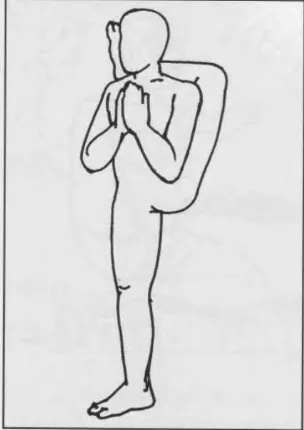

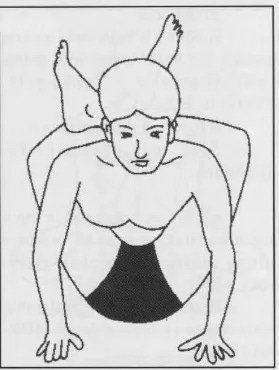
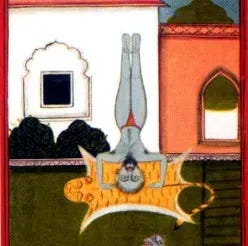
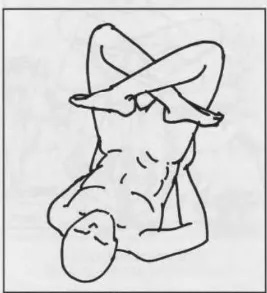
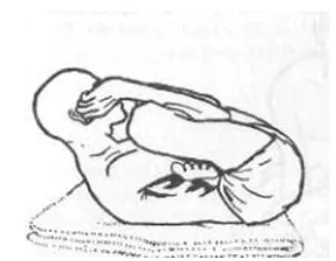


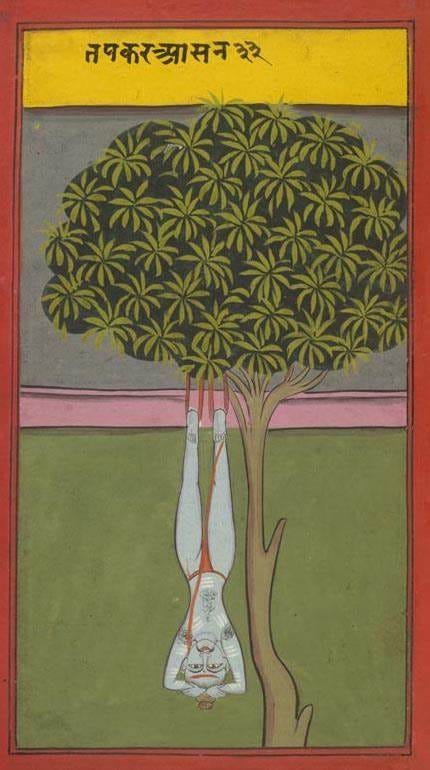
Thanks! terrydor@live.com
Dear Tsering Dorjii, my book on the Dawn of Physical Yoga has been published, I would like to send it to you, please send me your mail address. All the best, Giacomella Orofino